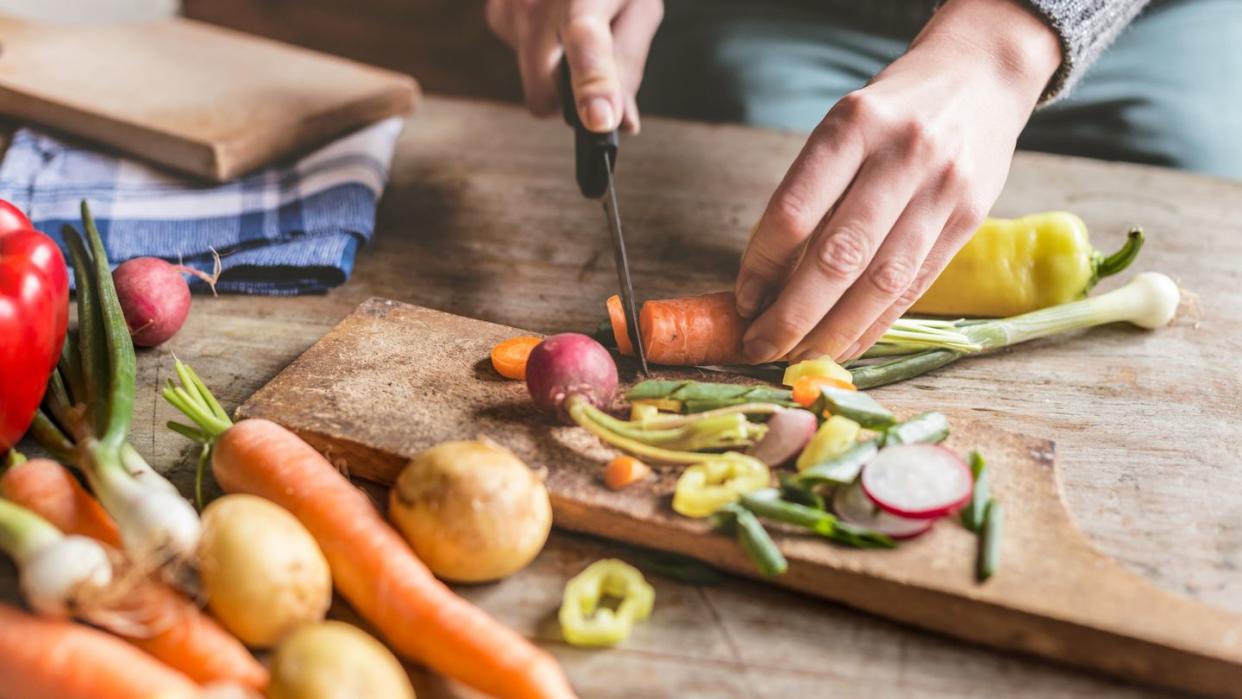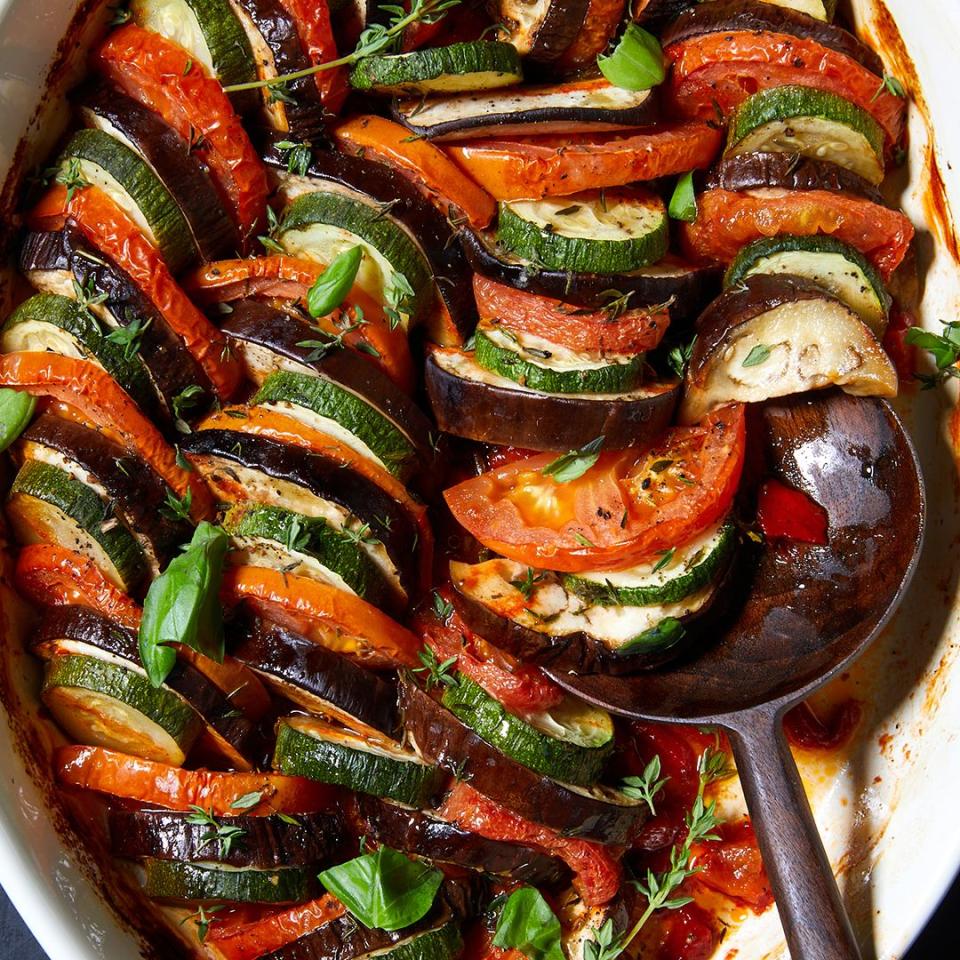Your Best Budget Resolution In 2024 Is Becoming A Vegetarian—Sorry

"Hearst Magazines and Yahoo may earn commission or revenue on some items through these links."
Last January, I asked the chef at a trendy restaurant located in a hospital (yes, you read that right) about his biggest food trend predictions. “More plant-based dishes,” said Adam Freisem, executive chef at Manna in Castle Rock, Colorado. The primary reason? Unprecedented inflation.
Tasked with keeping the menu affordable at his non-profit restaurant, Freisem was early to experiment with meaty blue oyster mushrooms and well-seasoned slabs of cauliflower, two lower-cost main dishes that win over even the most devout steak lovers. I checked back in with him this week, roughly a year later, and he’s gotten even more creative with his plant-based, cost-saving creations, like one that he calls the “corned beet reuben.”
People switch to vegetarian diets for all kinds of reasons—animal welfare concerns, health benefits, wanting to reduce their carbon footprints. But with the sticker shock of groceries and dining out, could saving money on food sway a new segment of cost-conscious consumers to become vegetarians? Or, at least, to eat plant-based meals more frequently and get in the habit of ordering meatless entrees at restaurants?
There’s certainly a case for it: In 2022, food prices rose nearly 11 percent in a one-year period, according to the consumer price index (CPI) report from the Bureau of Labor Statistics. The pace of inflation eased up some in the past year, with food costs going up 2.9 percent between November 2022 and November 2023, according to the most recent CPI report. So, if it seems like your grocery bills have ballooned since 2020, you’re not imagining it.
“Protein costs are still extremely high and constantly fluctuating, and vegetables are almost always less expensive than meat,” Freisem told me recently.
Over the past decade, vegetarian and vegan eating has remained pretty static, according to Gallup findings from August 2023, with 4 percent of Americans saying they’re vegetarians and 1 percent identifying as vegan. About 9 percent of liberals are vegetarian, the largest subgroup. However, income levels also have a powerful influence on who is eating vegetarian, so it’s possible that the rising cost of groceries could be a motivator to switch to plant-based eating in the near future. Seven percent of lower-income Americans have vegetarian diets, and they’re roughly twice more likely as middle-income (4 percent) and upper-income (3 percent) Americans to eat vegetarian diets, according to Gallup.
Considering eating more vegetarian meals in 2024 to lower your grocery bill? Here are some things you should know:
How Much Can You Save on Your Groceries By Switching to a Vegetarian Diet?
If you scan your grocery bill, it’s not surprising that some of the biggest ticket items are coming from the meat department. A one-pound bag of dry beans costs $1.57, compared to $6.73 for a pound of lean ground beef and $11.53 a pound for sirloin, according to the CPI.
“Plant-based eating is an extremely budget-friendly way to eat,” says Sophie Lauver M.S., R.D. with Plant-Based Perspective. “When we think of expensive plant-based diets, it’s usually because we’re thinking of processed plant-based meat alternatives.”

A plant-based whole-food diet, she says, saves money both in the short term and in the long term due to a reduced risk of chronic disease.
A few people I talked with who had recently adopted plant-based diets say their grocery bills plummeted by about 20 percent when they made the switch.
Recipe developer Yasmin Purnell adopted a vegetarian diet about five years ago, and she says saving money on her groceries was a “less-expected, but much-appreciated benefit” of her diet change. She spends about $150 a month on groceries for her and her toddler daughter, and she shares vegetarian dishes like lentil bolognese on her website By The Forkful.
Whenever anyone asks her about the cost savings that come with vegetarian eating, she suggests getting comfortable cooking with pantry staples such as beans, pulses, and legumes in addition to veggies and grains.
“It can be easy to opt for meat substitutes that look familiar, but these tend to be expensive alternatives to meat in comparison,” Purnell says.
Travel blogger Amanda Harper started eating plant-based recently, and changes like swapping lentils for ground beef in tacos and buying almond milk, which has a longer shelf life, helped her trim down her grocery bill from about $600 a month to $400 for two people.

But not all who go vegetarian end up saving money. In 2020, Kristin Hanes began cooking only vegetarian food, a lifestyle change motivated by a number of factors—health benefits, environmental reasons, and animal welfare. Plus, she splits her time between a campervan and sailboat, and having only vegetarian foods on board is more sanitary, she says.
She found cutting out meat didn’t have an impact on her monthly grocery bill, which is about $700 to $800 for two people, including wine and beer.
Part of that, she says, is because she’s buying high-quality, higher-priced items such as organic produce, organic canned goods, artisan cheeses and breads, vegan "meats" such as Impossible "ground meat," Morningstar burgers, Field Roast plant-based sausages, and so on.
“I also like international cooking, which requires buying spices, noodles, and sauces for Indian and Asian dishes,” Hanes says. “Those international ingredients add up.”
Expert Tips for Saving Money While Eating Vegetarian
Thinking about switching to a vegetarian diet but want to maximize cost savings and avoid some pitfalls? Registered dietitian Carolina Schneider, M.S., R.D., who works with companies like Daily Harvest and Forager Project to create nutrition content, gave us some of her best tips.
1. Prioritize Staple Food Items
Choose affordable whole grains like oats and brown rice and budget-friendly legumes such as beans, lentils, and chickpeas.
2. Buy in Bulk
Buying those non-perishable staples like whole grains, legumes, nuts, and seeds in larger quantities will net you a lower cost per unit (CPU). Grocery stores usually show the CPU so you can compare how much you save when you buy in bulk.
3. Stock up on Frozen Produce
Frozen fruits and veggies have a longer shelf life and retain their nutritional value, making them great options to have on hand.
4. Shop in Season
Seasonal fruits and vegetables are often more abundant and less expensive. Plus, it gives you a chance to try out new recipes as you rotate your produce with what’s in season.
5. Plan in Advance and Cook in Batches
Planning meals in advance and batch cooking can help you save time and money.
6. Cut the Processed Foods
Processed plant-based products are not only more expensive; they’re often less nutritious, too. Instead, focus on whole, minimally processed foods.
You Might Also Like

